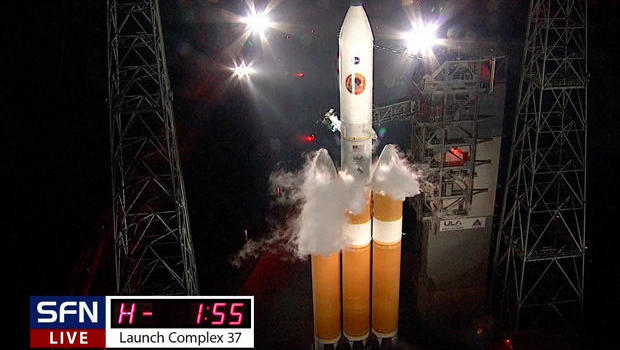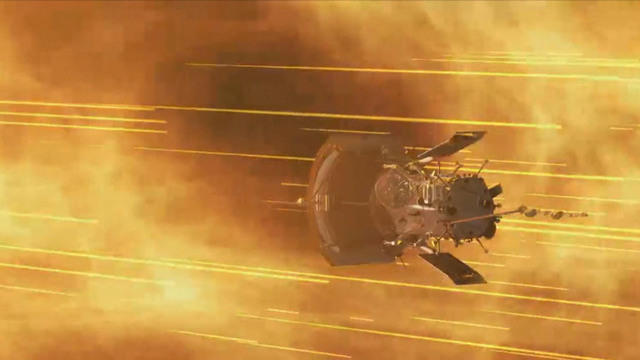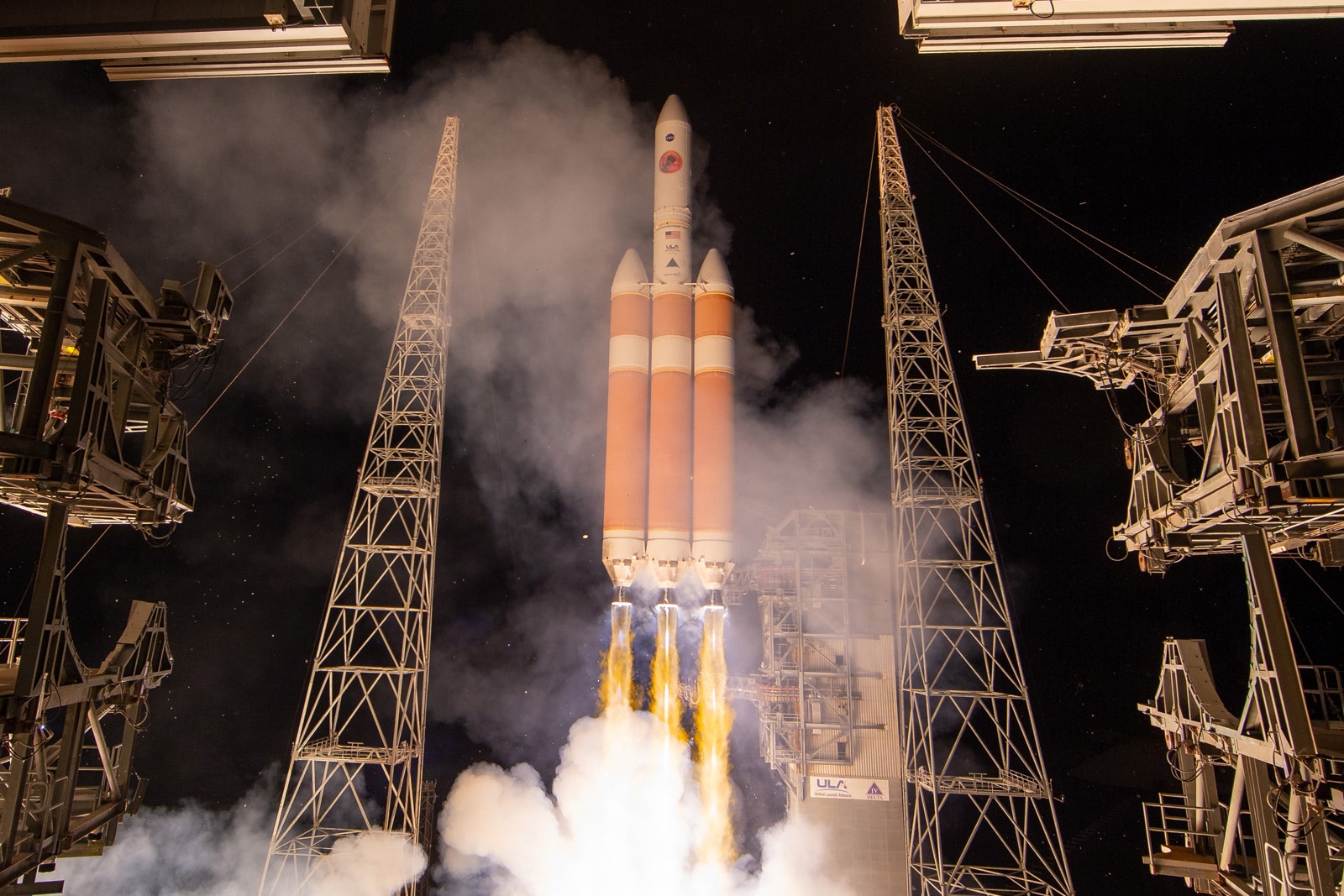New Mars Forums
You are not logged in.
- Topics: Active | Unanswered
Announcement
#1 2018-07-21 11:07:15
- SpaceNut
- Administrator
- From: New Hampshire
- Registered: 2004-07-22
- Posts: 29,867
Parker Solar Probe, a mission to touch the Sun
NASA prepares to launch Parker Solar Probe, a mission to touch the Sun

It has not launched yet but soon
Early on an August morning, the sky near Cape Canaveral, Florida, will light up with the launch of Parker Solar Probe. No earlier than Aug. 6, 2018, a United Launch Alliance Delta IV Heavy will thunder to space carrying the car-sized spacecraft, which will study the Sun closer than any human-made object ever has.
Our Sun is far more complex than meets the eye. Rather than the steady, unchanging disk it seems to human eyes, the Sun is a dynamic and magnetically active star. The Sun's atmosphere constantly sends magnetized material outward, enveloping our solar system far beyond the orbit of Pluto and influencing every world along the way. Coils of magnetic energy can burst out with light and particle radiation that travel through space and create temporary disruptions in our atmosphere, sometimes garbling radio and communications signals near Earth. The influence of solar activity on Earth and other worlds are collectively known as space weather, and the key to understanding its origins lies in understanding the Sun itself.
One of those questions is the mystery of the acceleration of the solar wind, the Sun's constant outflow of material. Though we largely grasp the solar wind's origins on the Sun, we know there is a point—as-yet unobserved—where the solar wind is accelerated to supersonic speeds. Data shows these changes happen in the corona, a region of the Sun's atmosphere that Parker Solar Probe will fly directly through, and scientists plan to use Parker Solar Probe's remote and in situ measurements to shed light on how this happens.
Second, scientists hope to learn the secret of the corona's enormously high temperatures. The visible surface of the Sun is about 10,000 F—but, for reasons we don't fully understand, the corona is hundreds of times hotter, spiking up to several million degrees F. This is counterintuitive, as the Sun's energy is produced at its core.
NASA’s Parker Solar Probe will ‘shake’ hands with sun, thanks to small push from Venus
Sending a spacecraft from Earth to a stationary target like the sun is like trying to throw a dart from a speeding train. That’s because Earth is barreling through space at 19 miles per second, or 67,000 miles per hour. No matter how fast we try to shoot the probe into space, its momentum will cause it to keep orbiting the sun.
The only way to get it close, Guo figures, is to slow the Parker Solar Probe way down, so it can achieve tighter orbits around the sun. To do that, the 1,400-pound probe will get a little help from Venus. The probe will fly just close enough to Venus so that it will get pulled toward the surface, allowing it to slow down and change its path–this is called a gravity assist.
Over the next seven years, as it circles the sun, the probe will wrap around Venus seven times, each time slowing down and swooping closer to the sun. In seven years, the probe will be within four million miles of the sun’s surface. In space terms, that’s practically shaking hands.
Every inch closer to the sun means the probe will be exposed to more excruciating heat and radiation. At its closest pass, in December 2024, the probe will be subjected to 2,500 degrees Fahrenheit — which is toasty but still pales in comparison to solar flares that reach tens of millions of degrees. The probe will be flying straight through coronal plasma, which is electrified gas that shoots out from the sun’s surface, hoping to miss these super hot flares. (Don’t worry, the chances of hitting a flare are low.)
Thanks to a state-of-the-art carbon-carbon heat shield, the Parker Solar Probe’s instruments will be kept at room temperature if everything goes as planned.
Offline
Like button can go here
#2 2018-08-10 19:51:31
- SpaceNut
- Administrator
- From: New Hampshire
- Registered: 2004-07-22
- Posts: 29,867
Re: Parker Solar Probe, a mission to touch the Sun
http://parkersolarprobe.jhuapl.edu/
Parker Solar Probe will swoop to within 4 million miles of the sun's surface, facing heat and radiation like no spacecraft before it.
Parker Solar Probe is a planned NASA robotic spacecraft to probe the outer corona of the Sun. It will approach to within 8.86 solar radii from the "surface" of the Sun and will travel, at closest approach, as much as 700,000 km/h.
Offline
Like button can go here
#3 2018-08-11 17:22:42
- SpaceNut
- Administrator
- From: New Hampshire
- Registered: 2004-07-22
- Posts: 29,867
Re: Parker Solar Probe, a mission to touch the Sun
NASA's $1.5 billion Parker Solar Probe atop a heavy-lift Delta 4 Heavy rocket

Still on the ground Parker Solar Probe launch delayed until Sunday
Countdown clocks stopped ticking at the T-minus one-minute 55-second point Saturday because of trouble with a helium pressurization system used by a United Launch Alliance Delta 4 Heavy rocket. NASA will make a second attempt to launch the Parker Solar Probe early Sunday.
The problem with a helium pressurization system could not be resolved in the 10 minutes left in the launch window, forcing ULA to order a 24-hour delay. "The team received a gaseous helium reg pressure alarm that kicked them out," said Mic Woltman with NASA's Launch Services Program. "The team is evaluating that. Unfortunately, we didn't have enough time this evening to go troubleshoot that and try again for a launch. So we're going to plan for a 24-hour turnaround."
We seenwhat that can do to a rocket...
The powerful Delta 4 Heavy and a solid-propellant upper stage will provide the energy needed to counteract Earth's 18-mile-per-second orbital velocity, allowing the Parker Solar Probe to fall into the inner solar system.
Once on its way, the spacecraft will fly through 24 elliptical orbits around the sun, eventually passing within just 3.8 million miles of the star's visible surface, enduring temperatures of 2,500 degrees as its instruments collect data from the closest vantage point ever attempted.

Hot, Hot, Hot
Offline
Like button can go here
#4 2018-08-12 08:46:13
- SpaceNut
- Administrator
- From: New Hampshire
- Registered: 2004-07-22
- Posts: 29,867
Re: Parker Solar Probe, a mission to touch the Sun
Comparitability of the probes that Nasa creates this one is cutting edge, even the Cassini and other were as high as this one for a first time event.
Curiosity Cost $2.5 Billion
https://luxatic.com/top-15-most-expensi … -programs/
The launch vehicles cost is in the 200 - 400 million of that budget dollars.
The next closest hot spot would be https://www.nasa.gov/planetmercury
Offline
Like button can go here
#5 2018-08-12 09:16:56
- SpaceNut
- Administrator
- From: New Hampshire
- Registered: 2004-07-22
- Posts: 29,867
Re: Parker Solar Probe, a mission to touch the Sun
We have liftoff NASA launches Parker Solar Probe in mission to 'touch' the Sun
Why our sun? To help humanity understand its home star.
ULA Delta IV Heavy rocket at 3:31AM 
The trip to the Sun will take a while. NASA's probe will pass by Venus a total of seven times (starting in early October) as it uses the planet's gravity to whip itself ever closer to the star. The spacecraft will make its first close approach in early November, when it will travel 15 million miles from the Sun -- inside the Sun's corona (aka the solar atmosphere). Its closest approach will put it at just 3.8 million miles from the Sun, at which point it should be the fastest-ever human-made object with a speed of 430,000MPH. The first science data should return sometime in December
It should help explain the corona's extreme heat, the forces driving the solar wind and the energetic particles that shoot out of the sun at more than half the speed of light.
This data will also apply to why mars is lossing atmosphere...
Offline
Like button can go here
#6 2018-10-27 21:04:03
- SpaceNut
- Administrator
- From: New Hampshire
- Registered: 2004-07-22
- Posts: 29,867
Re: Parker Solar Probe, a mission to touch the Sun
NASA solar Parker probe captures image of Earth
lots of words and no image....
will need to look for one...
Offline
Like button can go here
#7 2018-10-30 17:55:51
- SpaceNut
- Administrator
- From: New Hampshire
- Registered: 2004-07-22
- Posts: 29,867
Re: Parker Solar Probe, a mission to touch the Sun
NASA probe becomes closest spacecraft to the Sun
Parker Solar Probe is part of NASA’s Living With a Star program to explore aspects of the Sun-Earth system that directly affect life and society. The Living With a Star flight program is managed by the agency’s Goddard Space Flight Center in Greenbelt, Maryland, for NASA’s Science Mission Directorate in Washington.
The $1.5 billion Parker Solar Probe needed a ton of speed to escape Earth's orbit, hence the total of three rocket stages that fired during the launch. Parker Solar Probe will swoop to within 4 million miles of the sun's surface, facing heat and radiation like no spacecraft before it. NASA probe has become the closest spacecraft to the Sun, by getting within 26.55 million miles from the Sun, the NASA Parker Solar Probe broke the record for closest approach by a human-made object since 1976.
Offline
Like button can go here
#8 2018-10-31 20:57:37
- kbd512
- Administrator
- Registered: 2015-01-02
- Posts: 8,344
Re: Parker Solar Probe, a mission to touch the Sun
At 3.8 million miles, that probe is probably close enough to get BBQ'd by a CME. At that distance, it'd take just over an hour for the super-heated plasma to reach the probe.
Offline
Like button can go here
#9 2018-11-01 03:18:47
- elderflower
- Member
- Registered: 2016-06-19
- Posts: 1,262
Re: Parker Solar Probe, a mission to touch the Sun
They are going to approach closer and closer to the sun with each orbit, until it does get fried.
Offline
Like button can go here
#10 2018-11-01 18:42:55
- SpaceNut
- Administrator
- From: New Hampshire
- Registered: 2004-07-22
- Posts: 29,867
Re: Parker Solar Probe, a mission to touch the Sun
The probes design also points out that we can build for part of what will cause any probes trying to land in Venus is getting closure to reallity.
Offline
Like button can go here
#11 2019-08-04 18:50:07
- SpaceNut
- Administrator
- From: New Hampshire
- Registered: 2004-07-22
- Posts: 29,867
Re: Parker Solar Probe, a mission to touch the Sun
NASA Parker solar probe sends back data from its first two visits
The probe is going to get closer and go faster around our sun....
Offline
Like button can go here
#12 2020-06-15 20:01:13
- SpaceNut
- Administrator
- From: New Hampshire
- Registered: 2004-07-22
- Posts: 29,867
Re: Parker Solar Probe, a mission to touch the Sun
Offline
Like button can go here
#13 2021-12-14 19:28:54
- SpaceNut
- Administrator
- From: New Hampshire
- Registered: 2004-07-22
- Posts: 29,867
Re: Parker Solar Probe, a mission to touch the Sun
NASA craft 'touches' sun for 1st time, dives into atmosphere
The Parker Solar Probe actually flew through the corona in April during the spacecraft’s eighth close approach to the sun. Scientists said it took a few months to get the data back and then several more months to confirm.
Parker will keep drawing ever closer to the sun and diving deeper into the corona until its grand finale orbit in 2025.
Offline
Like button can go here
#14 2023-12-31 12:45:34
- SpaceNut
- Administrator
- From: New Hampshire
- Registered: 2004-07-22
- Posts: 29,867
Re: Parker Solar Probe, a mission to touch the Sun
NASA is on a mission to 'touch the Sun' in milestone moment for space exploration
NASA's Parker Solar Probe is set to pass the Sun on 24 December 2024.
It's due to fly past the sun at 195 km/s, or 435,000 mph.
Offline
Like button can go here
#15 2024-12-24 13:31:24
- tahanson43206
- Moderator
- Registered: 2018-04-27
- Posts: 23,382
Re: Parker Solar Probe, a mission to touch the Sun
SpaceNut's post #14 predicted the fly-by on December 24th, and a relative sent this update:
https://www.cnn.com/2024/12/23/science/ … id=ios_app
This update by Ashley Strickland has plenty of animation, and text explaining details of the design of the probe, and it's mission.
(th)
Offline
Like button can go here